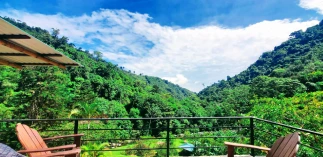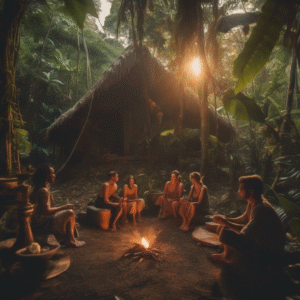Hiking trails in Costa Rica offer a blend of wild beauty, dramatic elevation changes, rich biodiversity, and unforgettable scenery. Whether you’re trekking through cloud forests, volcano paths, or coastal jungles, each step introduces a new texture of the country’s vibrant terrain. One key decision many travelers face when planning their outdoor experience is whether to choose a guided or self-guided hike. Both options offer unique advantages, and the right choice depends on your comfort level, preferences, and desired level of immersion.

What to Expect from Hiking Trails in Costa Rica?
Costa Rica’s landscape is a hiker’s paradise. Trails often wind through:
- Dense rainforests with hanging bridges
- Volcanic terrain with steaming vents and hardened lava flows
- Cloud forests are rich with epiphytes and bird species
- Coastal routes where jungle meets ocean
Elevations vary widely, and while some paths are well-marked and maintained, others are rugged and remote, better suited for experienced trekkers or those with local support.
Guided Hiking: Features and Advantages
Guided hikes are led by professionals familiar with the trails, ecosystems, and safety considerations. This option suits those who prefer a structured experience with educational depth.
Benefits of Guided Hiking:
- In-depth local knowledge: Guides often provide insights into flora, fauna, cultural history, and geology.
- Safety assurance: In remote or unfamiliar terrain, having someone who knows the path minimizes risk.
- Wildlife spotting: Trained eyes can point out camouflaged animals or rare plants most hikers would miss.
- Language support: English-speaking guides can help bridge communication gaps in rural areas.
- Permits and logistics handled: Some trails require advanced registration, entrance fees, or special permissions, which guides typically arrange.
Best For:
- First-time visitors to Costa Rica
- Hikers with limited experience in tropical environments
- Nature enthusiasts are eager to learn while trekking
- Groups or families seeking structured outings
Self-Guided Hiking: Features and Advantages
For more independent travelers, self-guided hiking provides flexibility and freedom. You set the pace, linger at viewpoints, or take spontaneous detours without the structure of a group.
Benefits of Self-Guided Hiking:
- Freedom to choose: Start when you want, stop when you like, and make the experience entirely your own.
- Privacy and solitude: Ideal for those who enjoy quiet reflection or uninterrupted time in nature.
- More budget-friendly: Without a guide fee, costs are often lower, especially on shorter routes.
- Adventure on your terms: Great for confident hikers who enjoy a sense of exploration.
Best For:
- Experienced hikers with strong navigation skills
- Solo travelers seeking solitude or creative time (photography, journaling)
- Those returning to familiar trails
- Budget-conscious visitors
Key Considerations Before Choosing
Regardless of which option you lean toward, a few important factors can help shape your decision:
- Trail Difficulty and Terrain: Rugged trails or poorly marked paths may require a guide, while well-maintained park routes may be safe to navigate solo.
- Weather Conditions: In Costa Rica’s wet season, trails can flood or become muddy and slippery. A guide can help adapt plans if the weather changes unexpectedly.
- Language Barrier: Spanish is the primary language in most rural areas. If you’re not comfortable with basic communication, a guide adds convenience and security.
- Physical Fitness: Some trails span several kilometers over steep or uneven ground. Consider your stamina and how much assistance you may need during the journey.
Pros and Cons: A Quick Comparison
| Feature | Guided Hiking | Self-Guided Hiking |
|---|---|---|
| Local insights | Extensive | Minimal unless self-researched |
| Flexibility | Limited to the tour schedule | High flexibility |
| Cost | Higher | More economical |
| Safety | High due to expert presence | Varies by location and preparation |
| Wildlife spotting | Excellent with trained eyes | May miss subtle sightings |
| Required permits | Often arranged by the guide | Must arrange on your own |
When to Mix Both Options
Some travelers find that combining both approaches works best. For instance, they may choose guided hikes for challenging or ecologically rich trails and go self-guided for shorter or familiar routes. Costa Rica’s diversity makes this hybrid style a practical and rewarding choice.
Essentials for a Safe Hike (Self-Guided or Guided)
Whether you’re going solo or joining a group, preparation is essential. Here are a few must-haves for your daypack:
- Refillable water bottle or hydration pack
- Lightweight rain jacket
- Sun protection (hat, sunscreen, sunglasses)
- Trail snacks or fruit
- Map, compass, or offline GPS app
- Basic first-aid kit
- Insect repellent
- Flashlight or headlamp
- Emergency contact info or local phone SIM
Recommended Safety Practices
- Always inform someone of your plans and estimated return time.
- Avoid hiking during heavy rains or near dusk.
- Stick to designated trails; going off-path can be dangerous and environmentally harmful.
- Observe wildlife at a distance; never feed or touch animals.
- Respect local communities and protected areas.
Why Choose Hotel Rivel?
Hotel Rivel offers a strategic base for accessing some of the most captivating hiking trails in Costa Rica. Nestled near both forested reserves and scenic mountain paths, our location allows guests to reach trailheads with ease, whether guided or self-guided.
At Hotel Rivel, we assist our guests with tailored hiking suggestions based on interest and skill level. Whether you’re interested in a quiet solo trek or a guided nature walk, our local support helps ensure a smooth, safe, and memorable experience. Clean, cozy accommodations, hearty meals, and tranquil mountain views round out your journey, offering rest and renewal after a day on the trail.







